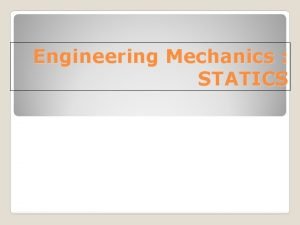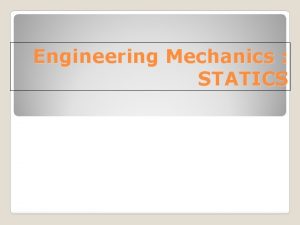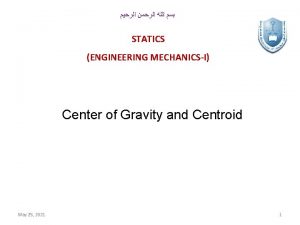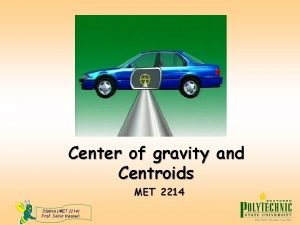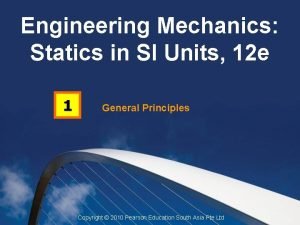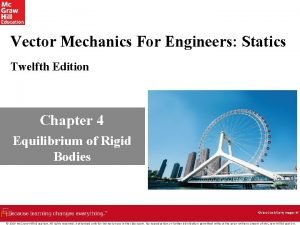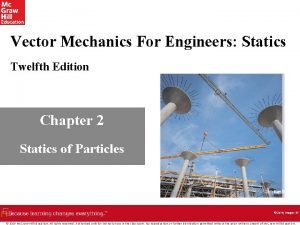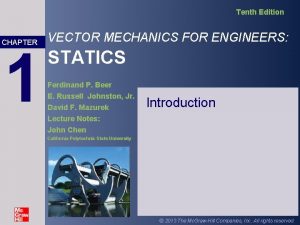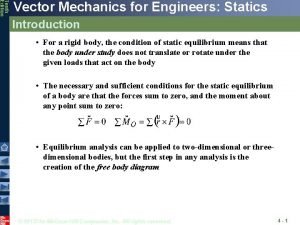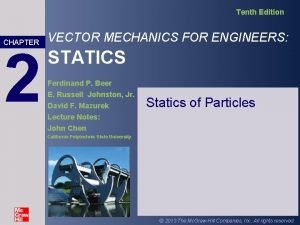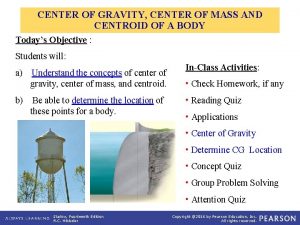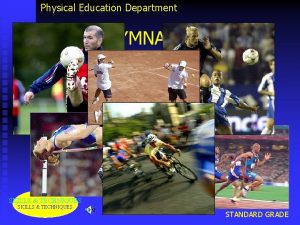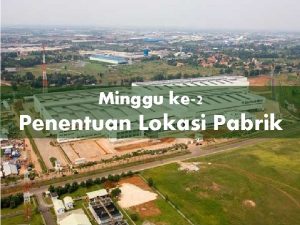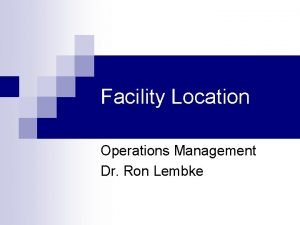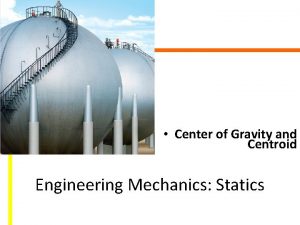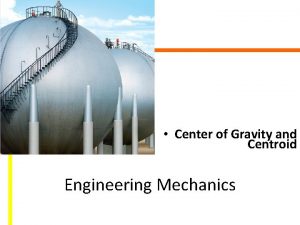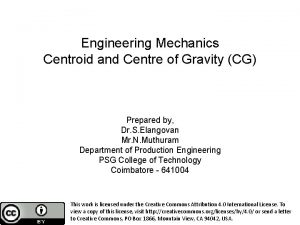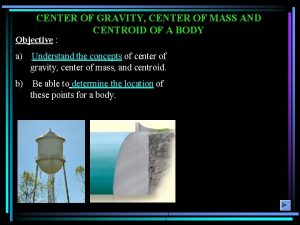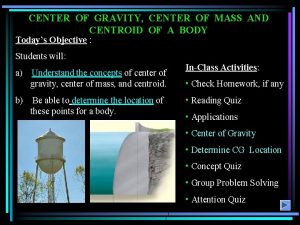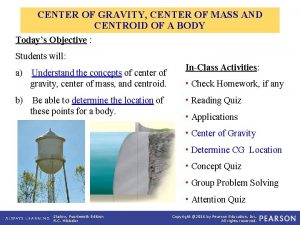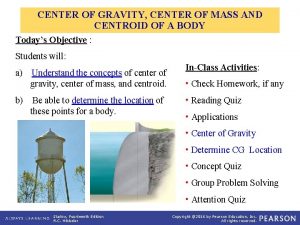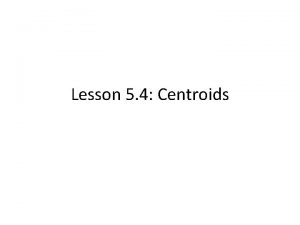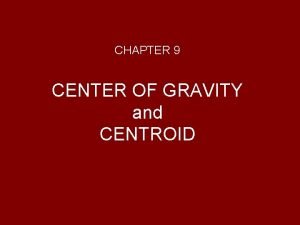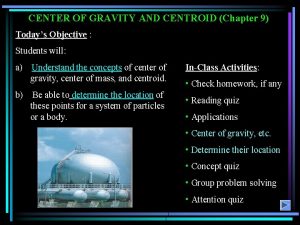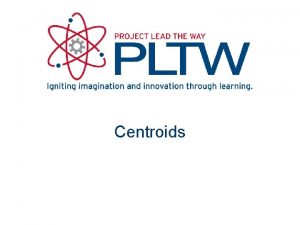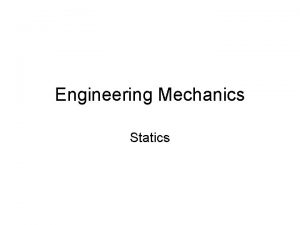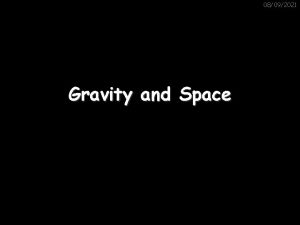Engineering Mechanics STATICS CENTER OF GRAVITY AND CENTROID




















- Slides: 20

Engineering Mechanics : STATICS

CENTER OF GRAVITY AND CENTROID Today’s Objective : Students will: a) Understand the concepts of center of gravity, center of mass, and centroid. Learning Topics: • Applications • Center of gravity, etc. 2

APPLICATIONS To design the structure for supporting a water tank, we will need to know the weights of the tank and water as well as the locations where the resultant forces representing these distributed loads are acting. How can we determine these weights and their locations? 3

REVIEW The net force on the beam is given by + FR = L d. F = L w(x) dx = A Here A is the area under the loading curve w(x). Assuming that FR acts at , it will produce the moment about point O as + MRO = ( ) (FR) = L xw(x) dx 4

REVIEW * First moment of Area The integral ∫ x d. A in the previous equation is known as the first moment of the area A with respect to the y axis and is denoted by Qy. Similarly, the integral ∫ y d. A is defined as the first moment of A with respect to x axis and is denoted by Qx. Therefore we can rewrite the previous equation as 5

INTRODUCTION • The earth exerts a gravitational force on each of the particles forming a body. These forces can be replace by a single equivalent force equal to the weight of the body and applied at the center of gravity for the body. • The centroid of an area is analogous to the center of gravity of a body. The concept of the first moment of an area is used to locate the centroid. • Determination of the area of a surface of revolution and the volume of a body of revolution are accomplished with the Theorems of Pappus. Guldinus. 6

CONCEPT OF CG AND CM 4 N 3 m A 1 N 1 m • G B The center of gravity (G) is a point which locates the resultant weight of a system of particles or body. 3 N From the definition of a resultant force, the sum of moments due to individual particle weight about any point is the same as the moment due to the resultant weight located at G. For the figure above, try taking moments about A and B. Also, note that the sum of moments due to the individual particle’s weights about point G is equal to zero. Similarly, the center of mass is a point which locates the resultant mass of a system of particles or body. Generally, its location is the same as that of G. 7

CONCEPT OF CG AND CM (Continued) • Center of gravity of a plate • Center of gravity of a wire 8

CONCEPT OF CENTROID The centroid C is a point which defines the geometric center of an object. The centroid coincides with the center of mass or the center of gravity only if the material of the body is homogenous (density or specific weight is constant throughout the body). If an object has an axis of symmetry, then the centroid of object lies on that axis. In some cases, the centroid is not located on the object. 9

CONCEPT OF CENTROID (Continued) • Centroid of an area • Centroid of a line γ = specified weight (weight per unit volume) t = thickness of the plate ΔA = area of the element a = cross-sectional area of the wire 10 ΔL = length of the element

CONCEPT OF CENTROID (Continued) 11

CONCEPT OF CENTROID (Continued) 12

CG / CM FOR A SYSTEM OF PARTICLES Consider a system of n particles as shown in the figure. The net or the resultant weight is given as WR = W. Summing the moments about the y-axis, we get ~ ~ ~ x WR = x 1 W 1 + x 2 W 2 + ………. . + xn. Wn ~ where x 1 represents x coordinate of W 1, etc. . Similarly, we can sum moments about the x and z-axes to find the coordinates of G. By replacing the W with a M in these equations, the coordinates of the center of mass can be found. 13

CG / CM / CENTROID OF A BODY (Section 9. 2) A rigid body can be considered as made up of an infinite number of particles. Hence, using the same principles as in the previous slide, we get the coordinates of G by simply replacing the discrete summation sign ( ) by the continuous summation sign ( ) and W by d. W. Similarly, the coordinates of the center of mass and the centroid of volume, area, or length can be obtained by replacing W by m, V, A, or L, respectively. 14

STEPS FOR DETERMING AREA CENTROID 1. Choose an appropriate differential element d. A at a general point (x, y). Hint: Generally, if y is easily expressed in terms of x (e. g. , y = x 2 + 1), use a vertical rectangular element. If the converse is true, then use a horizontal rectangular element. 2. Express d. A in terms of the differentiating element dx (or dy). 3. Determine coordinates (x~ , ~y ) of the centroid of the rectangular element in terms of the general point (x, y). 4. Express all the variables and integral limits in the formula using either x or y depending on whether the differential element is in terms of dx or dy, respectively, and integrate. Note: Similar steps are used for determining CG, CM, etc. . These steps will become clearer by doing a few examples. 15

EXAMPLE (Integration method) Given: The area as shown. Find: The centroid location (x , y) Plan: Follow the steps. Solution x, y • • ~ ~ x, y 1. Since y is given in terms of x, choose d. A as a vertical rectangular strip. 2. d. A = y dx = (9 – x 2) dx 3. x~ = x and ~ y = y/2 16

EXAMPLE (Continued) ~ 4. x = ( A x d. A ) / ( A d. A ) 3 = 2) d x x ( 9 – x 0 3 2) d x ( 9 – x 0 = [ 9 (x 2)/2 – (x 4) / 4] 03 [ 9 x – (x 3) / 3 ] 3 0 = ( 9 ) / 2 – 81 / 4 ) / ( 9 ( 3 ) – ( 27 / 3 ) ) = 1. 13 m 3 ~ y = A y d. A A d. A = ½ 0 ( 9 – x 2) dx 3 2) d x ( 9 – x 0 = 3. 60 m 17

CONCEPT QUIZ 1. The steel plate with known weight and nonuniform thickness and density is supported as shown. Of the three parameters (CG, CM, and centroid), which one is needed for determining the support reactions? Are all three parameters located at the same point? A) B) C) D) (center of gravity, no) (center of gravity, yes) (centroid, no) 2. When determining the centroid of the area above, which type of differential area element requires the least computational work? A) Vertical B) Horizontal C) Polar D) Any one of the above. 18

IN CLASS TUTORIAL Given: The area as shown. Find: The x of the centroid. Plan: Follow the steps. Solution (x 1, , y) (x 2, y) 1. Choose d. A as a horizontal rectangular strip. 2. d. A = ( x 2 – x 1) dy = ((2 – y) – y 2) dy 3. x = ( x 1 + x 2) / 2 = 0. 5 (( 2 – y) + y 2 ) 19

IN CLASS TUTORIAL (Continued) 4. x = ~ ( A x d. A ) / ( A d. A ) A d. A = 0 1 ( 2 – y 2) dy [ 2 y – y 2 / 2 – y 3 / 3] 01 = 1. 167 m 2 1 ~ A x d. A = 0 0. 5 ( 2 – y + y 2 ) ( 2 – y 2 ) dy x = 1 = 0. 5 0 ( 4 – 4 y + y 2 – y 4 ) dy = 0. 5 [ 4 y – 4 y 2 / 2 + y 3 / 3 – y 5 / 5 ] 1 = 1. 067 m 3 0 1. 067 / 1. 167 = 0. 914 m 20
 Centroid formula engineering mechanics
Centroid formula engineering mechanics Statics centroid
Statics centroid Center of gravity statics
Center of gravity statics Centroid engineering
Centroid engineering Statics centroid
Statics centroid Engineering mechanics: statics in si units
Engineering mechanics: statics in si units Force system resultants problems and solutions
Force system resultants problems and solutions Centroid
Centroid Gravity for dummies and dummies for gravity equations
Gravity for dummies and dummies for gravity equations Static equilibrium
Static equilibrium Vector mechanics for engineers statics 12th
Vector mechanics for engineers statics 12th Vector mechanics for engineers 10th edition
Vector mechanics for engineers 10th edition Mechanics
Mechanics Vector mechanics for engineers statics 10th edition
Vector mechanics for engineers statics 10th edition Mechanics for engineers
Mechanics for engineers Density and specific gravity formula
Density and specific gravity formula Define the term centre of gravity of a body
Define the term centre of gravity of a body Centre of gravity in gymnastics
Centre of gravity in gymnastics Contoh penentuan lokasi pabrik
Contoh penentuan lokasi pabrik Center of gravity method facility location example
Center of gravity method facility location example Contoh soal metode load distance
Contoh soal metode load distance
